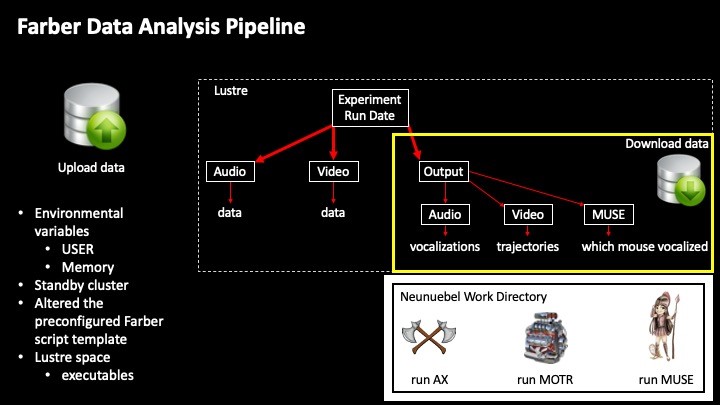Optimization of Mouse Social Behavior Data Analyses Pipeline

Project Information
bash, batch-jobs, environment-modules, job-sizing, lustre, matlab, nfs, putty, scheduling, sge, slurm, ssh, unix-environment, x11Project Status: Complete
Project Region: CAREERS
Submitted By: Anita Schwartz
Project Email: jneun@udel.edu
Project Institution: University of Delaware
Anchor Institution: CR-University of Delaware
Project Address: 210 South College Ave.
Newark, Delaware. 19716
Mentors: Josh Neunuebel, Anita Schwartz
Students: Joel Turk
Project Description
The Neunuebel Neuroscience Lab research team in the Department of Psychological Brain Sciences at the University of Delaware is interested in the mechanisms that the nervous system uses to process and integrate information, specifically social cues, during innate behavior. To understand the neural basis of social communication, the research team has built a unique, non-commercially available system for simultaneously recording audio and behavioral data from freely socializing mice. The system generates massive data sets that require the use of high-performance computing to analyze. Moreover, we developed a fully functional data processing pipeline on the University of Delaware’s second Community Cluster (Farber), ideally positioning the laboratory to conduct innovative research from socially interacting groups of mice. While the pipeline on the Farber cluster has been highly productive and beneficial, the University has upgraded to a more efficient and effective computing cluster that has a significantly longer shelf life (Caviness). Recently, the research team invested in the Caviness cluster and we are now looking to train a highly motivated, enthusiastic student eager to immerse themselves in high-performance computing with the end goal of optimizing the laboratory’s data analysis pipeline for use on the Caviness cluster.Additional Resources
Launch Presentation:Joel_Turk CAREERS Project Launch.pptx
(20.4 MB)
Wrap Presentation: 3

Project Information
bash, batch-jobs, environment-modules, job-sizing, lustre, matlab, nfs, putty, scheduling, sge, slurm, ssh, unix-environment, x11Project Status: Complete
Project Region: CAREERS
Submitted By: Anita Schwartz
Project Email: jneun@udel.edu
Project Institution: University of Delaware
Anchor Institution: CR-University of Delaware
Project Address: 210 South College Ave.
Newark, Delaware. 19716
Mentors: Josh Neunuebel, Anita Schwartz
Students: Joel Turk
Project Description
The Neunuebel Neuroscience Lab research team in the Department of Psychological Brain Sciences at the University of Delaware is interested in the mechanisms that the nervous system uses to process and integrate information, specifically social cues, during innate behavior. To understand the neural basis of social communication, the research team has built a unique, non-commercially available system for simultaneously recording audio and behavioral data from freely socializing mice. The system generates massive data sets that require the use of high-performance computing to analyze. Moreover, we developed a fully functional data processing pipeline on the University of Delaware’s second Community Cluster (Farber), ideally positioning the laboratory to conduct innovative research from socially interacting groups of mice. While the pipeline on the Farber cluster has been highly productive and beneficial, the University has upgraded to a more efficient and effective computing cluster that has a significantly longer shelf life (Caviness). Recently, the research team invested in the Caviness cluster and we are now looking to train a highly motivated, enthusiastic student eager to immerse themselves in high-performance computing with the end goal of optimizing the laboratory’s data analysis pipeline for use on the Caviness cluster.Additional Resources
Launch Presentation:Joel_Turk CAREERS Project Launch.pptx
(20.4 MB)
Wrap Presentation: 3